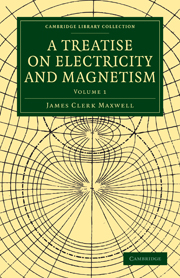Book contents
- Frontmatter
- PREFACE
- Contents
- ELECTRICITY AND MAGNETISM
- PRELIMINARY
- PART I ELECTROSTATICS
- PART II ELECTROKINEMATICS
- CHAPTER I THE ELECTRIC CURRENT
- CHAPTER II CONDUCTION AND RESISTANCE
- CHAPTER III ELECTROMOTIVE FORCE BETWEEN BODIES IN CONTACT
- CHAPTER IV ELECTROLYSIS
- CHAPTER V ELECTROLYTIC POLARIZATION
- CHAPTER VI MATHEMATICAL THEORY OF THE DISTRIBUTION OF ELECTRIC CURRENTS
- CHAPTER VII CONDUCTION IN THREE DIMENSIONS
- CHAPTER VIII RESISTANCE AND CONDUCTIVITY IN THREE DIMENSIONS
- CHAPTER IX CONDUCTION THROUGH HETEROGENEOUS MEDIA
- CHAPTER X CONDUCTION IN DIELECTRICS
- CHAPTER XI MEASUREMENT OF THE ELECTRIC RESISTANCE OF CONDUCTORS
- CHAPTER XII ELECTRIC RESISTANCE OF SUBSTANCES
- Plate section
CHAPTER II - CONDUCTION AND RESISTANCE
Published online by Cambridge University Press: 05 July 2011
- Frontmatter
- PREFACE
- Contents
- ELECTRICITY AND MAGNETISM
- PRELIMINARY
- PART I ELECTROSTATICS
- PART II ELECTROKINEMATICS
- CHAPTER I THE ELECTRIC CURRENT
- CHAPTER II CONDUCTION AND RESISTANCE
- CHAPTER III ELECTROMOTIVE FORCE BETWEEN BODIES IN CONTACT
- CHAPTER IV ELECTROLYSIS
- CHAPTER V ELECTROLYTIC POLARIZATION
- CHAPTER VI MATHEMATICAL THEORY OF THE DISTRIBUTION OF ELECTRIC CURRENTS
- CHAPTER VII CONDUCTION IN THREE DIMENSIONS
- CHAPTER VIII RESISTANCE AND CONDUCTIVITY IN THREE DIMENSIONS
- CHAPTER IX CONDUCTION THROUGH HETEROGENEOUS MEDIA
- CHAPTER X CONDUCTION IN DIELECTRICS
- CHAPTER XI MEASUREMENT OF THE ELECTRIC RESISTANCE OF CONDUCTORS
- CHAPTER XII ELECTRIC RESISTANCE OF SUBSTANCES
- Plate section
Summary
241.] If by means of an electrometer we determine the electric potential at different points of a circuit in which a constant electric current is maintained, we shall find that in any portion of the circuit consisting of a single metal of uniform temperature throughout, the potential at any point exceeds that at any other point farther on in the direction of the current by a quantity depending on the strength of the current and on the nature and dimensions of the intervening portion of the circuit. The difference of the potentials at the extremities of this portion of the circuit is called the External electromotive force acting on it. If the portion of the circuit under consideration is not homogeneous, but contains transitions from one substance to another, from metals to electrolytes, or from hotter to colder parts, there may be, besides the external electromotive force, Internal electromotive forces which must be taken into account.
The relations between Electromotive Force, Current, and Resistance were first investigated by Dr. G. S. Ohm, in a work published in 1827, entitled Die Galvanische Kette Mathematisch Bearbeitet, translated in Taylor's Scientific Memoirs. The result of these investigations in the case of homogeneous conductors is commonly called ‘Ohm's Law.’
Ohm's Law
The electromotive force acting between the extremities of any part of a circuit is the product of the strength of the current and the Resistance of that part of the circuit.
- Type
- Chapter
- Information
- A Treatise on Electricity and Magnetism , pp. 295 - 298Publisher: Cambridge University PressPrint publication year: 2010First published in: 1873

